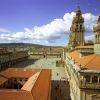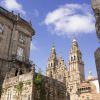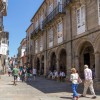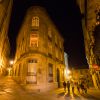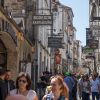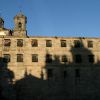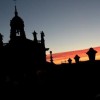- Accede I
- Regístrate I
- carrito
Alameda
Saliendo por la Porta Faxeira , una de las antiguas puertas de la desaparecida muralla, se llega a la Alameda. Este nombre genérico engloba en realidad de tres partes bien diferenciadas: el Paseo de la Alameda , la Carballeira (‘robledal' en gallego) de Santa Susana y el Paseo de la Herradura , que juntos suponen una extensión de 56 mil metros cuadrados. La unidad así formada es, desde el siglo XIX, uno de los paseos predilectos de los santiagueses, aunque no estén lejos los tiempos en que el espacio acogía cada jueves el mercado de ganado más típico de Galicia . Esa herencia festiva sigue tomando cuerpo en la noria y los tenderetes que pueblan los caminos y prados durante las fiestas de la Ascensión –el sexto jueves tras Pascua de Resurrección- o el día de Santiago Apóstol, el 25 de julio.
Una curiosa escultura de César Lombera, conocida como Las Dos Marías, da la bienvenida al parque. representan a dos personajes populares, hermanas y costureras de profesión, que emprendían a diario el mismo paseo, luciendo vistosos vestidos y elaborados maquillajes. A su derecha puede apreciarse, calle por medio, el Colegio de San Clemente,antiguo Colegio de Pasantes, fundado a comienzos del siglo XVII. Tras su fachada de líneas clásicas tiene su sede el Instituto de Educación Secundaria Rosalía de Castro.
El perímetro del parque se puede recorrer comenzando, por ejemplo, por el Paseo de los Leones, que arranca bajo el arco triunfal. Allí se topa el caminante con el escritor gallego Ramón del Valle Inclán inmortalizado en bronce, para llegar luego al eucalipto “de los enamorados” y admirar todo un clásico entre las postales de Compostela: la visión del Conjunto Histórico enmarcado entre las ramas de robles y olmos.










